Additive manufacturing: Can you print a car?
Collaborative demonstration dispels doubt about 3D printing’s disruptive potential for direct-to-digital manufacturing of just about anything BIG.
The undisputed highlight of the 2014 IMTS show (Sept. 8-13, Chicago, IL, US) was the world’s first 3D-printed composite body for an automobile. Conceived as a showcase for large-scale additive manufacturing capabilities developed through a public/private partnership anchored by Oak Ridge National Laboratory (ORNL, Oak Ridge, TN), the passenger cell or tub (seat frames, cockpit, hood and tail) and four fenders — five pieces total — for the 680-kg, battery-powered two-seater Strati were printed in 44 hours. The car subsequently was assembled in two days and driven off the IMTS Emerging Technology Exhibit stand before show’s end to cheers from the crowded exhibit floor.
The demonstration project, conceived by Local Motors (Chandler, AZ, US) CEO John B. Rogers, Jr., as the 3D Printed Car Design Challenge, took advantage of the large-format printing capabilities of the Big Area Additive Manufacturing (BAAM) machine, built by Cincinnati Incorporated (Harrison, OH) in cooperation with ORNL.
“We are a research institution, and not in the business of making cars,” notes Dr. Lonnie Love, head of ORNL’s Manufacturing Systems Research Group. “But Strati was a good test case. If you can print a car,” he quips, “you can print anything.” With 3D-printed parts already flying on commercial aircraft and being tested for jet engines, the implications of this direct-to-digital manufacturing (DDM) vehicle are, indeed, large and won’t be limited to aerospace and automotive applications.
“Can you print a car?”
The large-scale additive manufacturing concept originated with Lockheed Martin (Fort Worth, TX, US) back in the late 1990s. The ultimate vision was a “lights out” process for forming aircraft from advanced thermoplastic composites, using multiple, robotically controlled extrusion deposition heads. Sometime later, the US Department of Energy (DoE) tasked its Manufacturing Demonstration Facility (MDF) at ORNL with developing what is popularly known as 3D printing into an industrial-scale process. By 2013, Lockheed Martin had partnered with ORNL and moved its equipment to the MDF lab. Progress, however, was slow. “With robotic arms, small motions at the shoulder caused big motions at the tip, changing the accuracy and resolution,” explains Love, “Extruders are also heavy; so we adapted the system to a large gantry, which provides the necessary stiffness and support.”
In early 2014, Local Motors and Cincinnati Inc. entered the picture. “We had been asked by show organizers at the 2012 IMTS what we could do to challenge the machine tool manufacturing industry,” recalls Rogers. “We thought the concept of hitting a ‘print’ button and having a car come out the other end was very attractive.” Coincidentally, Cincinnati Inc. was seeking new markets. Both companies visited MDF in February 2014. Love recounts that Cincinnati Inc. reps said, “We can make and sell these.” Love’s team visited the machine manufacturer and agreed. Rogers’ visit was punctuated by questions about speed, cost and if prefab parts could be embedded, ending with, “Can you print a car?”
Cincinnati Inc. signed a cooperative R&D agreement (CRADA) with ORNL and Rogers committed all three companies to headline the 2014 IMTS Emerging Technology Center exhibit. Local Motors announced its 3D Printed Car Design Challenge in March and recognized the winner on May 24. Meanwhile, Cincinnati Inc. and ORNL worked to assemble the machine that would print Strati’s parts.
Fused deposition modeling on steroids
Although most 3D printers build parts the size of a shoebox, the print envelope of the resulting BAAM machine is almost 10 times larger, measuring 2m by 4m by 0.9m (x, y and z axes). A Cincinnati Inc. laser platform — CO2 and fiber lasers are among the 50,000+ machines built during the company’s 100-year history — provides the BAAM’s frame, motion system and control. Its linear motor drive enables BAAM to maintain a level bed while delivering positioning accuracy of ±0.025 mm per axis at deposition speeds up to 5,080 mm/sec.
“Laser-cutting and 3D-printing machines are similar in that both have a head that moves in space according to CNC programming,” explains Cincinnati Inc. marketing manager Matt Garbarino. “Our system, with the laser removed, provided plenty of range in the x- and y-axes, but still needed more than the typical 0.5m of movement in the z-direction.” So Cincinnati Inc. built a table that travels vertically to provide 0.9m of z-axis range.
In place of the laser, ORNL installed on BAAM its extruder and feeding system, which allows application of heated thermoplastic compound, layer by layer. Described affectionately as “an FDM machine on steroids,” BAAM with ORNL’s extruder/feeder has a deposition rate of 17 kg/hr — 200-400 times faster than the average 3D printer.
“Where FDM normally uses a spool of plastic thread,” Garbarino explains, “BAAM uses plastic pellets, similar to those for injection molding, so parts are also affordable.” These pellets are vacuum fed from a 2m by 2m by 2m hopper through a dryer into a single-screw extruder, which melts and forces the thermoplastic — with or without fiber reinforcement — through a standard 8-mm-diameter nozzle. “The bead is roughly 5 mm tall by 9 mm wide and round as it exits,” adds ORNL’s Love. “A tamping device vibrates up and down to push the bead into a rectangle and achieve a good bond with the layer below.” The printed layer thickness for Strati was ~4 mm.
“BAAM was designed to accommodate a wide variety of materials,” says Garbarino, “allowing more options for flexibility and low cost.” Trials to date have included acrylonitrile butadiene styrene (ABS), polyphenylene sulfide (PPS), polyphenylsulfone (PPSU or PPSF), polyetheretherketone (PEEK), polyetherketoneketone (PEKK), and polyetherimide (PEI). Both carbon and glass fiber reinforcements have been used, showing improved strength and thermal stability in printed parts. “Typically, fibers in these pellets are 5-7μ in diameter and 500μ to 0.5 mm in length, depending on the pellet size because the fibers are co-extruded with the polymers,” notes Love. ORNL also has tested polymers loaded with nanofibers and graphene, supplied by tailored injection compound specialist Techmer (Clinton, TN, US). Strati was printed using SABIC’s (Pittsfield, MA, US) LNP STAT-KON AE003, an ABS compound based on its CYCOLAC resin and containing 15% chopped carbon fiber.
Winning design to manufacturable print
Local Motors selected the Challenge winner, Italian designer Michele Anoé’s Strati (Italian for “layers” and pronounced “strotty”), from more than 200 entries submitted from 30 countries. It then began optimizing Strati’s 3D CAD files — developed using Solid Edge from Siemens PLM Software (Plano, TX, US) — for printing (see Step 1, at left). “We had to make sure that all of the areas were printable,” explains Rogers. “For example, if a wall was set as 19-mm thick but we could only print in 4-mm layers, then we needed to alter that dimension [to 20 mm] and make sure the whole design worked.”
“You also can’t just print in free space,” Love adds, “Wherever you have an overhang, you have to support it.”
Rogers concedes that this was a fairly manual inspection process, “but it was also the first time we had used a large-area additive manufacturing machine.” After this, Local Motors worked with ORNL’s in-house slicing software — now being transitioned to a commercial entity. “We sliced the designed solid into layers the machine could print,” says Rogers.
But one problem remained: “We had been growing parts at 4.5 kg/hr, so we were already two orders of magnitude faster than most 3D printers,” recalls Love. But with only 3-4 weeks to go, “this still wouldn’t be fast enough to assemble and drive the car off the stand before the show ended.” The team wasn’t ready to give up. “We had been working on a new extruder,” says Love, “and one week before IMTS, we swapped it into the system. We ran a trial print and it worked! We reached almost 18 kg/hr.”
Print, assemble, drive
Printing started on Sunday morning at 7 a.m. (Step 2), and by 6 a.m. Tuesday the car body’s main structure was completed as a single 454-kg piece of carbon fiber-reinforced plastic (CFRP). This was then transported by forklift (Step 4) to a 5-axis CNC router supplied by Thermwood Inc. (Dale, IN, US), where surfaces requiring smoothness (e.g., for application of decals) or further dimensioning were machined by the end of the day (Step 5). “For example, where a control arm must mate to a surface,” explains Rogers “you need to mill that to the exact dimensions, which is easy to do.” The machined tub was then returned to the exhibit booth on Thursday and staged for assembly (Steps 6, 7, 8). Mechanical components (wheels, wiring, brakes and suspension) were sourced from a variety of suppliers, including an electric powertrain from a Renault Twizy city car. With roll bar, windshield, lights, trim and seat covers in place (Step 9) — Strati was ready to roll (Step 10) at 9 am Saturday, Sept. 13. Right on schedule, Rogers drove Strati off the stand and out of the convention center.
Driving the process farther down the road
ORNL started trials of its next-generation extruder in January, capable of laying material at 45-68 kg/hr — it would reduce Strati’s print time to one day — see “Big Area Additive Manufacturing (BAAM): Increasing material feed and speed” at the end of this article, or click on its title under "Editor's Picks," at top right. Meanwhile, Cincinnati Inc. has expanded BAAM’s working envelope to 6m by 2.4m by 1.8m, increasing x-axis range by 50%, y-axis by 20% and doubling the z-axis travel (part height). This BAAM 100 ALPHA Size 2 machine, now installed at ORNL, replaces the Size 1 machine that has been relocated to Local Motors’ headquarters. Cincinnati Inc. also has sold a machine to SABIC for defining material processing parameters and another ALPHA Size 1 to a large aerospace entity. While the company pursues multiple ALPHA sales leads, it is finalizing a BETA version, geared for high-speed production and first deliveries later this year.
At the 2015 Detroit Auto Show (Jan 12-25, Detroit, MI, US), the partners demonstrated not only BAAM’s new speed and early crash test results, but also how to finish 3-D printed parts, showcased by ORNL’s 50th anniversary Shelby Cobra, with a Class A, painted surface (p. 56). The 635-kg vehicle (lightweight and kit versions average 1,070 kg) features 227 kg of parts printed from 20% carbon fiber-reinforced ABS over 25 hours. Only eight hours were required for the 3-D printed tooling, which was machined in four hours and cost $250. Built at the MDF using the BAAM 100 ALPHA Size 2, the tooling benefited from a 5-mm diameter nozzle that extruded a smaller bead, reducing surface variation to ±0.5 mm. TruDesign (Knoxville, TN, US) was a key partner, having investigated materials and methods for improved bonding between 3D printed layers and with coatings. “They completed several series of tooling for us,” says Love, “and performed the post-print machining and finishing.”
Rogers is confident that this technology is disruptive not only for the auto industry but also for manufacturing overall.
Composites and further paradigm shifts
“Carbon fiber is a game changer for additive manufacturing,” says Love. “It changes not only the stiffness and strength you can achieve, but also the coefficient of thermal expansion (CTE). By adding CF to the polymer, you can significantly limit the curl and warp of the final parts.” Aerospace tools for autoclave-cured parts must handle high temps with low CTE. Love’s group has demonstrated this ability by printing CFRP tooling for Cherry Point Marine Corps Air Station (Havelock, NC, US) where techs maintain aircraft no longer in production. “It cost more and took longer to ship these than it did to manufacture them,” Love notes and he points out that the military isn’t the only organization with this kind of need. “The appliance industry is massive. Manufacturers keep warehouses of tooling for 15 or 20 years, in case they have to make parts for out-of-production models. What if they could replace that with a digital archive and just print a tool when needed?”
Love says multiple automotive OEMs are thinking along the same lines for test vehicles, which can require up to US$50 million in tooling to output a short run of cars for a single new model. “What if you could simply 3D print these in composites vs. steel or aluminum? It would not only cut tooling costs, but also that model’s overall cycle time to production.”
Rogers, however, is serious about printing cars. “A lot of people will see this as a science project or prototype, but these are real vehicles that can be made in less than 12 months from design to drive on the road.” The design and build for the Strati took only six, and required only about 200 parts, compared to 20,000 in a typical car. “There are no tools, dies or patterns, saving tens of millions of dollars and months of lead time,” explains Rogers. “There are also no materials wasted.” Local Motors’ business plan is to reduce print and production time, enabling a target price of US$18,000 to US$30,000 and production of custom designs in micro-factories that it hopes to station around the world.
And Lockheed Martin’s original vision of “lights out” aircraft printing? Garbarino concedes, “This is not a lights-out process right now. But we are moving very quickly, and,” he claims, “we can definitely see that on the horizon.”
Related Content
SMC composites progress BinC solar electric vehicles
In an interview with one of Aptera’s co-founders, CW sheds light on the inspiration behind the crowd-funded solar electric vehicle, its body in carbon (BinC) and how composite materials are playing a role in its design.
Read MorePlant tour: Joby Aviation, Marina, Calif., U.S.
As the advanced air mobility market begins to take shape, market leader Joby Aviation works to industrialize composites manufacturing for its first-generation, composites-intensive, all-electric air taxi.
Read MoreInfinite Composites: Type V tanks for space, hydrogen, automotive and more
After a decade of proving its linerless, weight-saving composite tanks with NASA and more than 30 aerospace companies, this CryoSphere pioneer is scaling for growth in commercial space and sustainable transportation on Earth.
Read MoreMcLaren celebrates 10 years of the McLaren P1 hybrid hypercar
Lightweight carbon fiber construction, Formula 1-inspired aerodynamics and high-performance hybrid powertrain technologies hallmark this hybrid vehicle, serve as a springboard for new race cars.
Read MoreRead Next
New Details On Big Area Additive Manufacturing (BAAM) Project
The BAAM machine from Cincinnati Inc. continues to evolve with more pros involved so that by next year, the company will be taking orders for beta level and production machines.
Read MoreAll-recycled, needle-punched nonwoven CFRP slashes carbon footprint of Formula 2 seat
Dallara and Tenowo collaborate to produce a race-ready Formula 2 seat using recycled carbon fiber, reducing CO2 emissions by 97.5% compared to virgin materials.
Read More


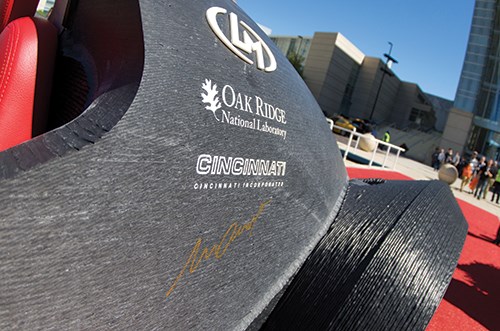
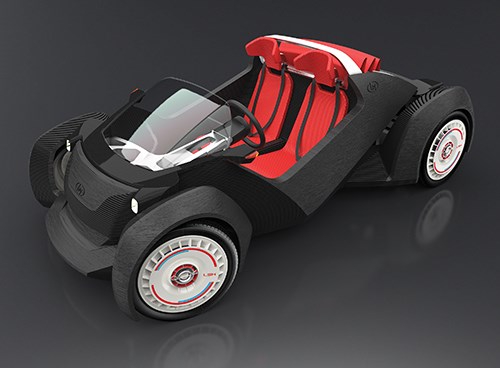
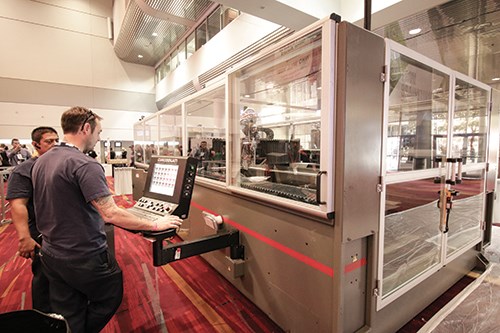
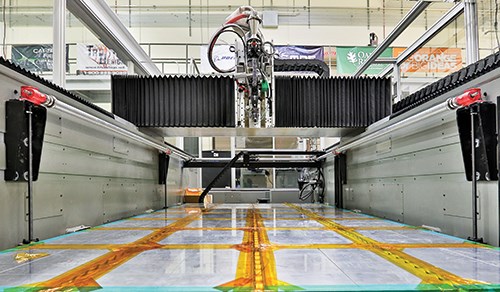


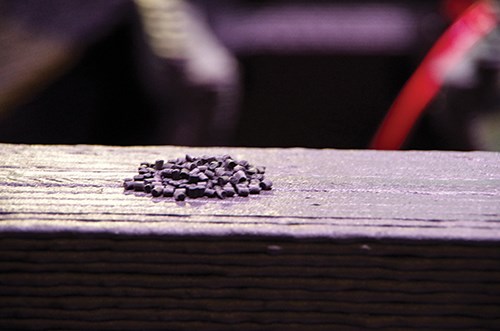


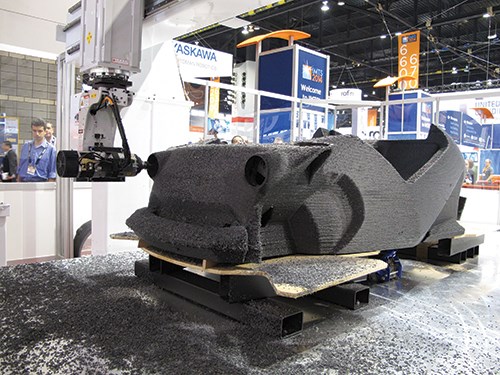






















.jpg;maxWidth=300;quality=90)











